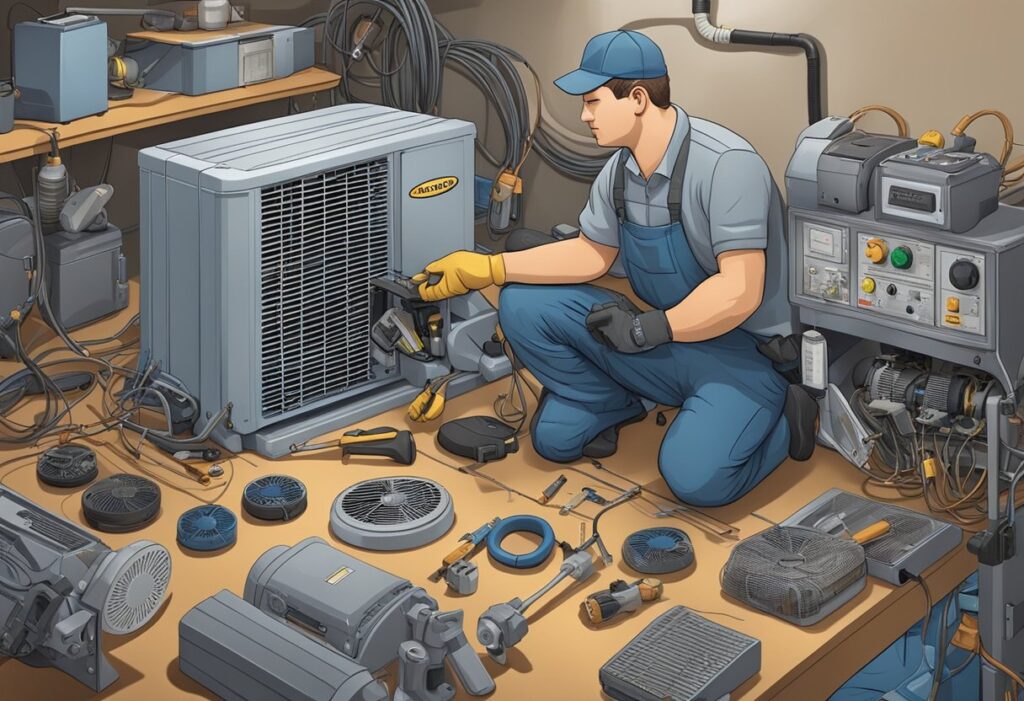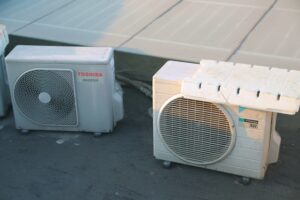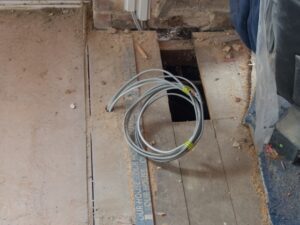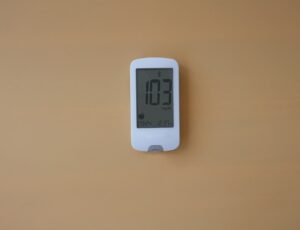Is your air conditioning system suddenly not cooling like it used to? Or perhaps it’s making strange noises, and you’re starting to wonder if your AC fan motor is the culprit. If that’s the case, you might be asking yourself, “How much will it cost to replace the fan motor?”
Replacing an AC fan motor can cost anywhere between $100 to $700. The cost range varies based on whether the motor is still under warranty. If it’s out of warranty, the price can lean toward the higher end of the spectrum, and you may also be looking at added labor costs.
But don’t stress — a healthy AC fan motor is vital to keeping your system running smoothly and ensuring your home stays cool during those scorching summer days. Plus, without it, your compressor could overheat, causing even bigger issues.
But here’s the thing: getting the right service to handle your AC maintenance is key. Not all service providers offer the same level of expertise and care. At Excel Mechanical, we specialize in HVAC and plumbing solutions that are both top-quality and cost-effective, ensuring you get the best bang for your buck.
Wondering if you need to replace your fan motor or if it can be repaired? Our team of professionals is here to guide you. Whether you’re a homeowner or a business owner, we tailor our services to meet your specific needs and budget.
You deserve a reliable, efficient system that works without fail. With Excel Mechanical, you get a partner who’s dedicated to keeping your space comfortable — no matter what.
In this blog, you will learn:
- The signs that your AC fan motor may need replacing
- What factors affect the cost of replacement
- How to choose the right service for your HVAC needs
Let’s get started!
Understanding AC Fan Motors
AC fan motors play a crucial role in your air conditioning system by driving the fan, which helps cool the air. This component is found in the condenser unit, typically outside your home. Your AC system will struggle to keep your home comfortable without a functioning fan motor.
Types of AC Fan Motors
- Single-Speed Motors: These operate at one constant speed and are often used in older models. They are less efficient compared to newer options.
- Variable-Speed Motors: These allow for multiple fan speeds, improving energy efficiency and comfort by adjusting to your cooling needs.
- ECM (Electronically Commutated Motors): These motors are known for being highly efficient. They adjust speed automatically and are often found in modern HVAC systems.
Key Performance Indicators
- Horsepower (HP): Indicates the power of the motor. Common values range from 1/8 to 1/2 HP.
- Revolutions Per Minute (RPM): Determines how fast the motor turns the fan blades.
- Amperage: A measure of electrical current the motor uses.
Signs of a Failing Motor
- Unusual noises like grinding or humming.
- Limited airflow from the vents.
- The fan not turning on or shutting off unexpectedly.
The Importance of a Properly Functioning AC Fan Motor
An AC fan motor plays a crucial role in your air conditioning system.
It circulates air across the evaporator coil, helping to keep your home cool and comfortable. If the motor is not working properly, the system can’t cool efficiently, leading to higher energy bills and reduced comfort.
A well-functioning fan motor prevents the AC unit from overheating. It maintains airflow, ensuring that other components, like the compressor, are not overworked. This can extend the life of your entire system and reduce the need for costly repairs.
Regular maintenance can keep the fan motor in good shape. This includes cleaning, lubricating, and inspecting the motor for wear. Catching issues early can save you from unexpected breakdowns and expenses.
Identifying a Faulty AC Fan Motor
Recognizing a faulty AC fan motor is crucial for maintaining an efficient cooling system.
A failing motor can lead to issues, such as poor airflow and potential damage to your air conditioning unit. This section outlines symptoms and diagnostic methods to help you identify problems early.
Common Symptoms of a Failing AC Fan Motor
When an AC fan motor starts to fail, you may notice unusual noises. These can include grinding, humming, or squealing sounds from the unit. Strange noises often indicate worn-out motor bearings or other mechanical issues.
Low airflow is another sign. If your air conditioner is running, but the airflow feels weak, the fan motor might not function correctly. This can reduce cooling efficiency and cause the system to work harder.
Another symptom is the AC unit frequently turning on and off. This is known as short cycling, and it can strain the motor and lead to overheating. Monitoring these symptoms can help you address issues before they worsen.
Diagnostic Methods
To diagnose a failing AC fan motor, check the thermostat settings and ensure they’re accurate. Incorrect settings can cause malfunction but are usually not the motor’s fault.
Next, inspect the motor for visible signs of damage. Look for burnt wires, rust, or physical damage. Testing the motor’s electrical connections with a multimeter can help verify if it’s getting power.
If you cannot handle these tasks, consider contacting a professional. Proper diagnosis and timely repair can prevent further issues.
Factors Affecting the Cost of Replacement
Many factors come into play when replacing an AC fan motor. These include the type of AC unit, fan motor specifications, labor costs, and where you live. Understanding each of these can help you estimate expenses more accurately.
Type of AC Unit
Different AC units have varying designs and complexities, affecting replacement costs. Residential systems might be less expensive since they often use standard parts.
Due to their size and complexity, commercial AC units might require specialized components or more skilled labor, leading to increased costs. If you own a central air conditioning unit, it might cost more due to its complex setup.
Knowing what type of AC unit you have is important. It helps you anticipate potential costs and choose the best service option.
Fan Motor Specifications
Specifications like size, speed, and efficiency directly impact cost.
Motors with higher horsepower typically cost more due to increased power and performance. Energy-efficient models might have higher upfront costs but save money in the long run by reducing electricity bills. Motors with special features or custom designs also raise costs.
Knowing your specific requirements will help you choose the right model when replacing your fan motor. This ensures optimal performance and value for money.
Labor Costs
The amount charged for labor varies based on expertise and location. Professional HVAC services often charge for their high skill level and quality.
Hiring experienced technicians can ensure the job is done right, preventing future issues. Some technicians charge hourly, which might lead to higher costs if the job takes longer than expected.
To manage expenses, inquire about flat-rate pricing and always confirm labor costs before starting any project.
Geographical Location
Prices for replacement parts and labor can differ significantly depending on your location. Expect to pay more for parts and labor in regions with high living costs.
Conversely, areas with lower living costs usually have cheaper rates. Access to parts also affects costs. In more remote areas, availability might be limited, leading to delays and higher fees. Consider local pricing trends and availability when budgeting for your AC fan motor replacement.
Estimated Cost Range for Replacing an AC Fan Motor
The cost of replacing an AC fan motor can vary widely based on factors such as warranty status, labor rates, and the specific type of unit you have.
Typical Costs Without Warranty:
- Overall Range: $200 – $700
- Labor Charges: $75 – $150 per hour
- Time for Replacement: 1 to 2 hours
If your unit is under warranty, costs are lower, typically ranging from $100 to $300. This is because only labor costs might apply. Without a warranty, however, you cover both parts and labor.
Replacing an AC fan motor might also require additional services, such as replacing a run capacitor, which typically costs between $220 and $250.
If you need reliable service, consider choosing Excel Mechanical. We specialize in providing high-quality HVAC and plumbing solutions tailored to your needs and budget. Our team of professionals ensures exceptional service whether you require residential or commercial HVAC updates.
Step-by-Step Replacement Process
Replacing an AC fan motor involves careful preparation, removing the faulty component, installing the new motor, and testing the system to ensure smooth operation. These steps are crucial for tackling the replacement task effectively and safely.
Preparation and Safety
Before starting, gather all necessary tools, such as screwdrivers, pliers, and a multimeter. The correct replacement motor must also be ready. Double-check that the power to the AC unit is switched off at the breaker to prevent any electrical accidents.
Use protective gear like gloves and safety glasses. Identify the motor’s location and access the AC unit’s wiring diagram if available.
Proper preparation ensures a safer and more organized work environment.
Removal of the Old Fan Motor
To remove the old fan motor, first dismantle any panels blocking access.
Carefully disconnect the wiring connected to the motor, noting the wire colors and their connections for reinstallation. Loosen and remove the mounting screws or bolts securing the motor in place.
Gently lift the motor out of its housing, avoiding damaging surrounding components. Clear any debris or dust that may have accumulated in the area, as cleanliness aids in the longevity of the new motor.
Installation of the New Fan Motor
Position the new motor into the vacant housing, ensuring alignment with mounting points.
Secure it with screws or bolts previously removed. Reconnect the wires, consulting your notes or any available diagrams to ensure correct connections.
Make sure that all electrical connections are secure. This step is vital to prevent operational issues. Reattach any removed panels, verifying they are firmly in place to avoid vibrations or noise during operation.
System Testing Post-Replacement
Once the new motor is secured, restore power to the AC unit.
Turn on the system to test the new motor. Listen for unusual sounds or vibrations, which may indicate improper installation or a faulty motor. Observe the motor and fan blade movement to ensure smooth operation.
We recommend periodic checks to ensure the replacement process is successful. Regular maintenance by skilled professionals can enhance the longevity and performance of your AC unit.
Choosing the Right Replacement Fan Motor
When replacing your AC fan motor, selecting the right one is crucial to ensure efficiency and longevity. Key factors include compatibility with your system and the quality of the motor itself.
Compatibility with Your AC System
It is vital to select a fan motor that fits your AC model.
Each system has specific requirements, such as size, power, and electrical specifications. Ensure the replacement motor matches these specifications to avoid unnecessary modifications or inefficiencies.
Check the model number and specifications of your current motor.
Cross-reference these details with potential replacements to ensure a proper fit. Mismatched components can lead to decreased performance or even damage your AC unit.
Quality and Brand Considerations
The quality of the fan motor directly impacts the lifespan and performance of your AC system.
Opt for reputable brands known for reliability and durability. While some motors may be cheaper upfront, investing in a high-quality product can save you from frequent replacements and repairs.
Excel Mechanical provides top-notch HVAC services, ensuring you receive the best quality replacement parts for residential and commercial needs. Our professionals prioritize exceptional quality and value, tailoring solutions to fit your budget and system needs.
Consider partnering with us for a seamless and reliable replacement process.
Potential Additional Costs
When replacing an AC fan motor, it’s important to consider extra expenses beyond the main installation. These can arise from deciding between a repair or full replacement and the need for additional parts and supplies.
Repair vs. Replacement
Deciding between repairing the existing fan motor or a full replacement impacts costs. Repairing is often less expensive, especially if the issue is minor. Depending on the complexity, repairs range from $100 to $300.
If replacement is necessary, while the motor might be covered under warranty, labor costs can range from $75 to $150 per hour. When the total cost of repairs approaches that of a new motor, replacement may be the better long-term option.
Choosing a trusted provider ensures you receive honest assessments. Skilled technicians help determine whether repair or replacement offers better value and longevity for your budget.
Additional Parts and Supplies
Apart from the motor itself, several other parts may need updates.
Components like capacitors, contactors, and fan blades often incur additional costs. For example, replacing a run capacitor can add $10 to $100 to the bill.
Other minor parts may increase the expense by another $20 to $50. Skilled Excel Mechanical technicians will thoroughly assess your system and recommend necessary replacements.
Additional supplies, such as wiring or mounting hardware might also be required. These ensure the new motor functions optimally for years to come. Investing in quality parts can prevent future issues and improve overall system efficiency.
Warranty and Longevity of New AC Fan Motors
When investing in a new AC fan motor, it’s essential to consider both warranty and longevity. Warranties can vary in length and coverage, with some lasting for a year while others extend to five years or more. To avoid unexpected costs, check what your warranty covers, like parts and labor.
The longevity of an AC fan motor depends on several factors. Quality, proper installation, and regular maintenance all play a role. A well-maintained motor can last anywhere from 10 to 15 years. Regular cleaning and timely repairs help extend the lifespan of your AC fan motor.
With careful installation and upkeep, your new fan motor will serve you well for years and be backed by a solid warranty.
Professional Installation vs. DIY Replacement
When considering replacing an AC fan motor, you can choose between professional installation and DIY replacement. Each option has its pros and cons.
Professional Installation
Hiring a professional ensures the job is done safely and correctly.
Professionals bring expert knowledge and experience to handle complex tasks. Labor costs can range from $100 to $300 or more, depending on the job’s complexity and your location’s labor rates.
Professionals are equipped with the right tools and provide warranties on their work, giving you peace of mind.
DIY Replacement
Opting for a DIY approach may save on labor costs. You can avoid the additional fees associated with hiring a professional. However, this option requires knowledge about AC units.
DIY replacements involve purchasing the correct parts and being comfortable with tools. If you lack experience, mistakes can be costly, potentially leading to further repairs or safety hazards.
Always consider the complexity of the task before proceeding on your own.
Comparison Table
| Aspect | Professional Installation | DIY Replacement |
| Cost | Higher due to labor fees | Lower but risks exist |
| Safety | Safer with expert technicians | Personal risk |
| Skill Required | Minimal for you | High skill needed |
| Quality Assurance | Guaranteed by professionalism | Depends on your ability |
Choosing between these options depends on your comfort level, budget, and the complexity of your repair task.
Frequently Asked Questions
When your AC fan motor starts acting up, it’s easy to feel overwhelmed. You’re probably asking, “Do I need to replace the whole motor?” or “What could this cost me?” Don’t worry — we’ve got you covered. Let’s dive into some of the most common questions people ask when facing an AC fan motor replacement.
What is the average cost of replacing an AC unit fan motor?
The average cost to replace an AC fan motor is around $450. If your motor is under warranty, you might pay less, typically between $100 to $300, while out-of-warranty replacements can go up to $700.
How much does an air conditioner blower motor replacement typically cost?
Replacing an air conditioner blower motor usually costs between $150 and $500. The price depends on factors like the model and size of your unit and any additional labor required.
What are the signs that my AC fan motor may need to be replaced?
Common signs include unusual noises from your unit, weak airflow, or the fan not spinning. If you notice these issues, consult with a professional to assess whether a replacement is necessary.
What factors influence the cost of a fan motor for an AC unit?
Several factors can affect the cost, such as the type of motor, the brand of your unit, and whether any additional repairs are needed. Labor costs vary, typically from $75 to $150 per hour.
Can the price of AC fan motor replacement vary by location?
Yes, location can significantly impact the price. Urban areas often have higher labor rates than rural regions. You may also find that parts and services are priced differently depending on local demand.
Is replacing the fan motor on an air conditioner a cost-effective option?
Replacing the fan motor can be cost-effective if it extends the life of your AC unit. It’s often cheaper than replacing the entire system. Consulting with companies like Excel Mechanical helps ensure you make a choice that balances quality and budget.




